#230: Lichenomphalia umbellifera
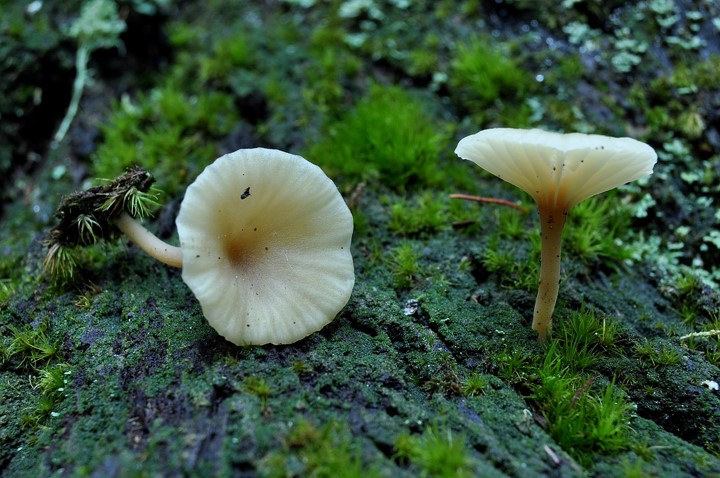
Nearly all lichens belong to the Ascomycota, but there are some lichenized basidiomycetes (often called “basidiolichens”)… and a few of those actually form mushrooms! Lichenomphalia umbellifera is a lichen that forms a small agaric. If you find this mushroom, you would probably dismiss it as just another LBM, unless you notice the lichen at its base. The lichen part of this mushroom consists of tiny green bubbles that seem to be sprinkled over its substrate. You’re most likely to find L. umbellifera in the Pacific Northwest – just remember not to overlook the small mushrooms!1
Description
L. umbellifera is a small brownish gilled mushroom with a circular pileus and central stipe. It grows 0.5-2.5cm across and 1-3cm tall, making it very easy to overlook. When young, the cap is brown and flat with an inrolled margin. As the mushroom grows, the cap develops yellowish tones and becomes depressed in the center. Sometimes the central depression becomes very deep and funnel-shaped. The margin unfurls with age and usually becomes pleated or scalloped, making the cap look slightly veined. Underneath the cap, the gills are pale yellowish, decurrent, and widely spaced from each other. The gills sometimes fork or form veins linking adjacent gills. The stipe attaches to the center of the pileus and is reddish-brown at the tip. Toward the center of the stipe, the colors fade to yellow-brown or light yellowish and the stipe often curves. The base of the stipe is usually slightly enlarged and covered with pale fuzz. L. umbellifera is considered inedible.1–3
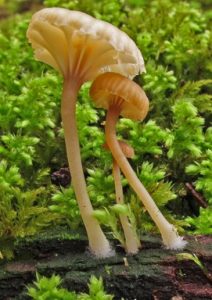
The lichen part of the fungus (which is the main body of the fungus) consists of small green globs. The globs appear dusted over the surface of the substrate like a weird kind of powdered sugar. Microscopically, the lichen has an outer layer of clear hyphae followed by a layer of gelatinous material and finally a clump of algal cells in the middle. Hyphae also crisscross the interior of the glob.4 This is very different than the well-organized structures formed by ascomycotan lichens.
Ecology
You can find L. umbellifera fruiting on the ground, in moss, or on fallen conifer logs in the summer (or possibly in other seasons in warmer climates).1–3 Of course, the lichen part is present all year round, but it’s much easier to identify when there is a mushroom growing from it. L. umbellifera grows on every continent except Antarctica, but is rare in most places.1–3,5 It is common in the Pacific Northwest and in arctic areas, so keep an eye out for this amazing little fungus when you’re in those regions.1–3
To form a lichen, L. umbellifera associates with green algae in the genus Coccomyxa.1 Coccomyxa species also form lichens with Ascomycota species. Because of this, I suspect that Lichenomphalia evolved its lichen ecology by copying ascomycotan lichens (I couldn’t find any scientific studies looking at how L. umbellifera became lichenized, so you’ll have to make do with my speculation). There are ascomycotan lichens that grow on the ground, so a Lichenomphalia ancestor could have evolved to grow hyphae into an ascomycotan lichen and steal the sugars produced by the algae – essentially parasitizing the ascomycotan lichen. Over time, it could have evolved the cellular machinery to duplicate what the ascomycotan lichen was doing and eventually was able to create a suitable home for Coccomyxa without needing the ascomycotan lichen. At this point it ceased to be a parasite and became a full lichen. Of course, this is mere speculation and would be difficult – if not impossible – to prove. Still, researching how basidiomycete mushrooms evolved into lichens would be fascinating because of all the weird relationships involved. (Have I convinced you to quit your job and become a mycologist yet?)
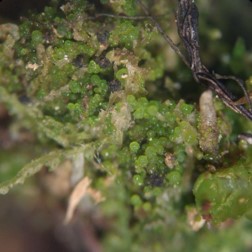
Similar species
There are lots of small mushrooms that are poorly represented in field guides, so there are many species with which you could confuse L. umbellifera. Clitocybe, Marasmius, Mycena, and Laccaria are the most likely sources of confusion. The easiest way to tell L. umbellifera apart is looking for the lichen at the base of the mushroom. There are other species of Lichenompalia, but they are less common and I am unaware of any other members of that genus that grow in North America.
Taxonomy
L. umbellifera belongs in the family Hygrophoraceae,6 which includes the waxy caps (FFF#182). Waxy caps – especially Hygrocybe species – are often small and normally appear in the same kinds of habitats that L. umbellifera prefers. Since most mushrooms in the Agaricales and Hygrophoraceae are not lichenized, Lichenomphalia probably developed its lichen ecology recently and independently of any other basidiomycotan lichens.
Until 2002, the lichen part had a different name from the mushroom. Mycologists knew the two fungi were always found together, but it took a long time to figure out that the two parts were actually the same fungus. The lichen was known as Botrydina vulgaris. The mushroom had several names over the years, some of which you might encounter in older publications. The most common names are: Omphalina umbellifera, Omphalia umbellifera, and Omphalina ericetorum.1–3,6
| Kingdom | Fungi |
| Subkingdom | Dikarya |
| Division (Phylum) | Basidiomycota |
| Subdivision (Subphylum) | Agaricomycotina |
| Class | Agaricomycetes |
| Subclass | Agaricomycetidae |
| Order | Agaricales |
| Family | Hygrophoraceae |
| Subfamily | Lichenomphalioideae |
| Genus | Lichenomphalia |
| Species | Lichenomphalia umbellifera (L.) Redhead, Lutzoni, Moncalvo & Vilgalys6 |
See Further:
https://www.mykoweb.com/CAF/species/Lichenomphalia_umbellifera.html https://www.mycoquebec.org/bas.php?post=Lichenomphalia&l=r&nom=Lichenomphalia%20umbellifera%20/%20Omphale%20en%20ombelle&tag=Lichenomphalia%20umbellifera&gro=23 (in French) http://forestrydev.org/cgi-bin/matchmaker/latin.asp (search for “Omphalina ericetorum”)Citations
- Wood, M. & Stevens, F. California Fungi—Lichenomphalia umbellifera. The Fugi of California http://www.mykoweb.com/CAF/species/Lichenomphalia_umbellifera.html.
- Labbé, R. Lichenomphalia umbellifera / Omphale en ombelle. Les champignons du Québec https://www.mycoquebec.org/bas.php?post=Lichenomphalia&l=r&nom=Lichenomphalia%20umbellifera%20/%20Omphale%20en%20ombelle&tag=Lichenomphalia%20umbellifera&gro=23 (2014).
- MatchMaker. Matchmaker: Mushrooms of the Pacific Northwest http://forestrydev.org/cgi-bin/matchmaker/latin.asp (2009).
- J. M. C. A primitive lichen. Botanical Gazette 14, 76 https://www.journals.uchicago.edu/doi/pdfplus/10.1086/330113 (1910).
- Lichen Agaric (Lichenomphalia umbellifera). iNaturalist https://www.inaturalist.org/taxa/118245-Lichenomphalia-umbellifera.
- Lichenomphalia umbellifera. Mycobank http://www.mycobank.org/BioloMICS.aspx?TableKey=14682616000000067&Rec=411746&Fields=All.

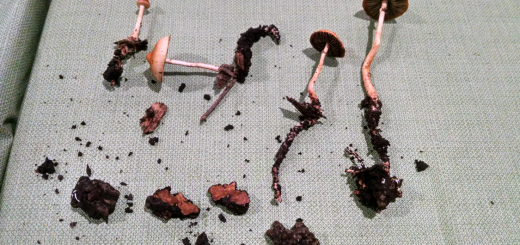






![#011: Characteristics of Kingdom Fungi [Archived]](https://www.fungusfactfriday.com/wp-content/themes/hueman/assets/front/img/thumb-small-empty.png)

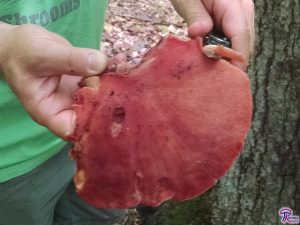
The little mushrooms I have found a very bright orange when fresh. They looked to be attached to moss and I don’t see a lichen. They are rowing in my lawn in Vancouver, WA
There are many little bright orange mushrooms and most are not attached to lichens. Although, Lichenomphalia umbellifera often doesn’t look like it’s attached to a lichen because the lichen body consists of very tiny green circles. My guess, however, is that your mushrooms are either Rickenella fibula or some kind of waxcap (Hygrocybe spp.).